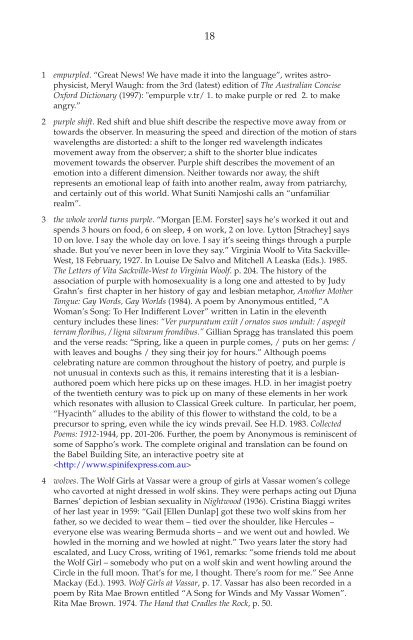Butterfly Effect - ressourcesfeministes
Butterfly Effect - ressourcesfeministes
Butterfly Effect - ressourcesfeministes
Create successful ePaper yourself
Turn your PDF publications into a flip-book with our unique Google optimized e-Paper software.
18<br />
1 empurpled. “Great News! We have made it into the language”, writes astrophysicist,<br />
Meryl Waugh: from the 3rd (latest) edition of The Australian Concise<br />
Oxford Dictionary (1997): "empurple v.tr/ 1. to make purple or red 2. to make<br />
angry.”<br />
2 purple shift. Red shift and blue shift describe the respective move away from or<br />
towards the observer. In measuring the speed and direction of the motion of stars<br />
wavelengths are distorted: a shift to the longer red wavelength indicates<br />
movement away from the observer; a shift to the shorter blue indicates<br />
movement towards the observer. Purple shift describes the movement of an<br />
emotion into a different dimension. Neither towards nor away, the shift<br />
represents an emotional leap of faith into another realm, away from patriarchy,<br />
and certainly out of this world. What Suniti Namjoshi calls an “unfamiliar<br />
realm”.<br />
3 the whole world turns purple. “Morgan [E.M. Forster] says he’s worked it out and<br />
spends 3 hours on food, 6 on sleep, 4 on work, 2 on love. Lytton [Strachey] says<br />
10 on love. I say the whole day on love. I say it’s seeing things through a purple<br />
shade. But you've never been in love they say.” Virginia Woolf to Vita Sackville-<br />
West, 18 February, 1927. In Louise De Salvo and Mitchell A Leaska (Eds.). 1985.<br />
The Letters of Vita Sackville-West to Virginia Woolf. p. 204. The history of the<br />
association of purple with homosexuality is a long one and attested to by Judy<br />
Grahn’s first chapter in her history of gay and lesbian metaphor, Another Mother<br />
Tongue: Gay Words, Gay Worlds (1984). A poem by Anonymous entitled, “A<br />
Woman’s Song: To Her Indifferent Lover” written in Latin in the eleventh<br />
century includes these lines: “Ver purpuratum exiit / ornatos suos unduit: / aspegit<br />
terram floribus, / ligna silvarum frondibus.” Gillian Spragg has translated this poem<br />
and the verse reads: “Spring, like a queen in purple comes, / puts on her gems: /<br />
with leaves and boughs / they sing their joy for hours.” Although poems<br />
celebrating nature are common throughout the history of poetry, and purple is<br />
not unusual in contexts such as this, it remains interesting that it is a lesbianauthored<br />
poem which here picks up on these images. H.D. in her imagist poetry<br />
of the twentieth century was to pick up on many of these elements in her work<br />
which resonates with allusion to Classical Greek culture. In particular, her poem,<br />
“Hyacinth” alludes to the ability of this flower to withstand the cold, to be a<br />
precursor to spring, even while the icy winds prevail. See H.D. 1983. Collected<br />
Poems: 1912-1944, pp. 201-206. Further, the poem by Anonymous is reminiscent of<br />
some of Sappho’s work. The complete original and translation can be found on<br />
the Babel Building Site, an interactive poetry site at<br />
<br />
4 wolves. The Wolf Girls at Vassar were a group of girls at Vassar women’s college<br />
who cavorted at night dressed in wolf skins. They were perhaps acting out Djuna<br />
Barnes’ depiction of lesbian sexuality in Nightwood (1936). Cristina Biaggi writes<br />
of her last year in 1959: “Gail [Ellen Dunlap] got these two wolf skins from her<br />
father, so we decided to wear them – tied over the shoulder, like Hercules –<br />
everyone else was wearing Bermuda shorts – and we went out and howled. We<br />
howled in the morning and we howled at night.” Two years later the story had<br />
escalated, and Lucy Cross, writing of 1961, remarks: “some friends told me about<br />
the Wolf Girl – somebody who put on a wolf skin and went howling around the<br />
Circle in the full moon. That’s for me, I thought. There’s room for me.” See Anne<br />
Mackay (Ed.). 1993. Wolf Girls at Vassar, p. 17. Vassar has also been recorded in a<br />
poem by Rita Mae Brown entitled “A Song for Winds and My Vassar Women”.<br />
Rita Mae Brown. 1974. The Hand that Cradles the Rock, p. 50.

















